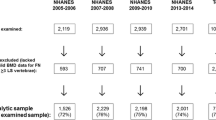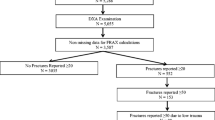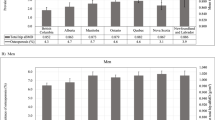Abstract
Summary
In nine industrialized countries in North America, Europe, Japan, and Australia, country-specific osteoporosis prevalence (estimated from published data) at the total hip or hip/spine ranged from 9 to 38 % for women and 1 to 8 % for men. In these countries, osteoporosis affects up to 49 million individuals.
Purpose
Standardized country-specific prevalence estimates are scarce, limiting our ability to anticipate the potential global impact of osteoporosis. This study estimated the prevalence of osteoporosis in several industrialized countries (USA, Canada, five European countries, Australia, and Japan) using the World Health Organization (WHO) bone mineral density (BMD)-based definition of osteoporosis: BMD T-score assessed by dual-energy x-ray absorptiometry ≤−2.5.
Methods
Osteoporosis prevalence was estimated for males and females aged 50 years and above using total hip BMD and then either total hip or spine BMD. We compiled published location-specific data, using the National Health and Nutrition Examination Survey (NHANES) III age and BMD reference groups, and adjusted for differences in disease definitions across sources. Relevant NHANES III ratios (e.g., male to female osteoporosis at the total hip) were applied where data were missing for countries outside the USA. Data were extrapolated from geographically similar countries as needed. Population counts for 2010 were used to estimate the number of individuals with osteoporosis in each country.
Results
For females, osteoporosis prevalence ranged from 9 % (UK) to 15 % (France and Germany) based on total hip BMD and from 16 % (USA) to 38 % (Japan) when spine BMD data were included. For males, prevalence ranged from 1 % (UK) to 4 % (Japan) based on total hip BMD and from 3 % (Canada) to 8 % (France, Germany, Italy, and Spain) when spine BMD data were included.
Conclusions
Up to 49 million individuals met the WHO osteoporosis criteria in a number of industrialized countries in North America, Europe, Japan, and Australia.



Similar content being viewed by others
References
US Department of Health and Human Services (2004) Bone health and osteoporosis: a report of the Surgeon General. U.S. Department of Health and Human Services, Office of the Surgeon General, Rockville, MD
Harvey N, Dennison E, Cooper C (2010) Osteoporosis: impact on health and economics. Nat Rev Rheumatol 6:99–105
Cummings SR, Bates D, Black DM (2002) Clinical use of bone densitometry: scientific review. JAMA 288:1889–1897
International Osteoporosis Foundation Guidelines incorporating FRAX. Available at http://www.iofbonehealth.org/national-regional-osteoporosis-guidelines. Accessed February 22 2011
Dawson-Hughes B, Looker AC, Tosteson AN, Johansson H, Kanis JA, Melton LJ 3rd (2010) The potential impact of new National Osteoporosis Foundation guidance on treatment patterns. Osteoporos Int 21:41–52
World Health Organization (1994) Assessment of fracture risk and its application to screening for postmenopausal osteoporosis. WHO Technical Report Series 843. World Health Organization, Geneva
National Health and Nutrition Examination Survey 1988-1994 (NHANES III). Available at http://www.cdc.gov/nchs/nhanes/nh3data.htm. Accessed September 3 2010
National Health and Nutrition Examination Survey 2005-2008. Available at http://www.cdc.gov/nchs/nhanes/nhanes_questionnaires.htm. Accessed April 25 2011
Centers for Disease Control and Prevention (1989) Third National Health and Nutrition Examination Survey (NHANES). Bone densitometry manual. Available at www.cdc.gov/nchs/data/nhanes/nhanes3/cdrom/NCHS/MANUALS/BONE.PDF. Accessed September 14 2010
Centers for Disease Control and Prevention (2009) Dual energy x-ray absorptiometry - femur bone measurements (DXXFEM_D). Available at http://www.cdc.gov/nchs/nhanes/nhanes2005-2006/DXXFEM_D.htm. Accessed June 9 2011
Tenenhouse A, Joseph L, Kreiger N, Poliquin S, Murray TM, Blondeau L, Berger C, Hanley DA, Prior JC (2000) Estimation of the prevalence of low bone density in Canadian women and men using a population-specific DXA reference standard: the Canadian Multicentre Osteoporosis Study (CaMos). Osteoporos Int 11:897–904
Leslie WD, Tsang JF, Lix LM (2008) Effect of total hip bone area on osteoporosis diagnosis and fractures. J Bone Miner Res 23:1468–1476
Sanfelix-Genoves J, Reig-Molla B, Sanfelix-Gimeno G, Peiro S, Graells-Ferrer M, Vega-Martinez M, Giner V (2010) The population-based prevalence of osteoporotic vertebral fracture and densitometric osteoporosis in postmenopausal women over 50 in Valencia, Spain (the FRAVO study). Bone 47:610–616
del Puente A, Heyse SP, Mandes MG, Mantova D, Carpinelli A, Nutile G, Oriente P (1998) Epidemiology of osteoporosis in women in southern Italy. Aging (Milano) 10:53–58
Kanis JA, Gluer CC (2000) An update on the diagnosis and assessment of osteoporosis with densitometry. Committee of Scientific Advisors, International Osteoporosis Foundation. Osteoporos Int 11:192–202
Naves M, Diaz-Lopez JB, Gomez C, Rodriguez-Rebollar A, Serrano-Arias M, Cannata-Andia JB (2005) Prevalence of osteoporosis in men and determinants of changes in bone mass in a non-selected Spanish population. Osteoporos Int 16:603–609
Holt G, Khaw KT, Reid DM et al (2002) Prevalence of osteoporotic bone mineral density at the hip in Britain differs substantially from the US over 50 years of age: implications for clinical densitometry. Br J Radiol 75:736–742
Yoshimura N, Muraki S, Oka H et al (2009) Prevalence of knee osteoarthritis, lumbar spondylosis, and osteoporosis in Japanese men and women: the research on osteoarthritis/osteoporosis against disability study. J Bone Miner Metab 27:620–628
Ikeda Y, Iki M, Morita A, Aihara H, Kagamimori S, Kagawa Y, Matsuzaki T, Yoneshima H, Marumo F (2002) Age-specific values and cutoff levels for the diagnosis of osteoporosis in quantitative ultrasound measurements at the calcaneus with SAHARA in healthy Japanese women: Japanese population-based osteoporosis (JPOS) study. Calcif Tissue Int 71:1–9
Henry MJ, Pasco JA, Nicholson GC, Seeman E, Kotowicz MA (2000) Prevalence of osteoporosis in Australian women: Geelong Osteoporosis Study. J Clin Densitom 3:261–268
Australian Bureau of Statistics (1996) Census. Catalogue No.2020.0
Hernlund E, Svedbom A, Ivergard M, Compston J, Cooper C, Stenmark J, McCloskey EV, Jonsson B, Kanis JA (2013) Osteoporosis in the European Union: medical management, epidemiology and economic burden. A report prepared in collaboration with the International Osteoporosis Foundation (IOF) and the European Federation of Pharmaceutical Industry Associations (EFPIA). Arch Osteoporos 8:136
Kanis JA, Johnell O (2005) Requirements for DXA for the management of osteoporosis in Europe. Osteoporos Int 16:229–238
Bultink IE, Baden M, Lems WF (2013) Glucocorticoid-induced osteoporosis: an update on current pharmacotherapy and future directions. Expert Opin Pharmacother 14:185–197
Strom O, Borgstrom F, Kanis JA, Compston J, Cooper C, McCloskey EV, Jonsson B (2011) Osteoporosis: burden, health care provision and opportunities in the EU: a report prepared in collaboration with the International Osteoporosis Foundation (IOF) and the European Federation of Pharmaceutical Industry Associations (EFPIA). Arch Osteoporos 6:59–155
Warriner AH, Saag KG (2013) Osteoporosis diagnosis and medical treatment. Orthop Clin North Am 44:125–135
Kanis JA, McCloskey EV, Johansson H, Oden A, Melton L Jr, Khaltaev N (2008) A reference standard for the description of osteoporosis. Bone 42:467–475
US Department Health and Human Services. Arthitis, osteoporosis and back conditions. In: Healthy people 2010. 2nd ed. Washington: US Government Printing Office; 2000:17-18
Looker AC, Borrud LG, B. D-H, Shepherd JA, Wright NC (2012) Osteoporosis or low bone mass at the femur neck or lumbar spine in older adults: United States, 2005-2008. NCHS data brief no 93. National Center for Health Statistics, Hyattsville, MD
Looker AC, Melton L Jr, Harris TB, Borrud LG, Shepherd JA (2010) Prevalence and trends in low femur bone density among older US adults: NHANES 2005-2006 compared with NHANES III. J Bone Miner Res 25:64–71
ISCD 2007 ISCD Official Positions - adult reference database for T-scores. Available at http://www.iscd.org/official-positions/2007-iscd-official-positions-adult/. Accessed October 20 2010
Faulkner KG, Orwoll E (2002) Implications in the use of T-scores for the diagnosis of osteoporosis in men. J Clin Densitom 5:87–93
Wiemann LM, Vallarta-Ast N, Krueger D, Binkley N (2007) Effect of female database use for T-score derivation in men. J Clin Densitom 10:244–248
Olszynski WP, Shawn Davison K, Adachi JD et al (2004) Osteoporosis in men: epidemiology, diagnosis, prevention, and treatment. Clin Ther 26:15–28
Sone T, Fukunaga M (2004) Prevalence of osteoporosis in Japan and the international comparison. Nihon Rinsho 62(Suppl 2):197–200
Iki M, Kagamimori S, Kagawa Y, Matsuzaki T, Yoneshima H, Marumo F (2001) Bone mineral density of the spine, hip and distal forearm in representative samples of the Japanese female population: Japanese Population-Based Osteoporosis (JPOS) Study. Osteoporos Int 12:529–537
Kanis JA, Oden A, Johnell O et al (2007) The use of clinical risk factors enhances the performance of BMD in the prediction of hip and osteoporotic fractures in men and women. Osteoporos Int 18:1033–1046
Acknowledgments
Amgen Inc. sponsored this study. Michelle N. Bradley and Mandy Suggitt of Amgen Inc. provided formatting and editing assistance.
Conflicts of interest
SWW: Consultant to Amgen Inc.
CS: Consultant to Amgen Inc.
LAF: Stock ownership in Amgen Inc., and employee of and owns stock/stock options in GlaxoSmithKline
MAS and CDO: Employees of and may own stock/stock options in Amgen Inc.
Author information
Authors and Affiliations
Corresponding author
Electronic supplementary material
Below is the link to the electronic supplementary material.
ESM 1
(DOCX 15.2 kb)
Rights and permissions
About this article
Cite this article
Wade, S.W., Strader, C., Fitzpatrick, L.A. et al. Estimating prevalence of osteoporosis: examples from industrialized countries. Arch Osteoporos 9, 182 (2014). https://doi.org/10.1007/s11657-014-0182-3
Received:
Accepted:
Published:
DOI: https://doi.org/10.1007/s11657-014-0182-3




